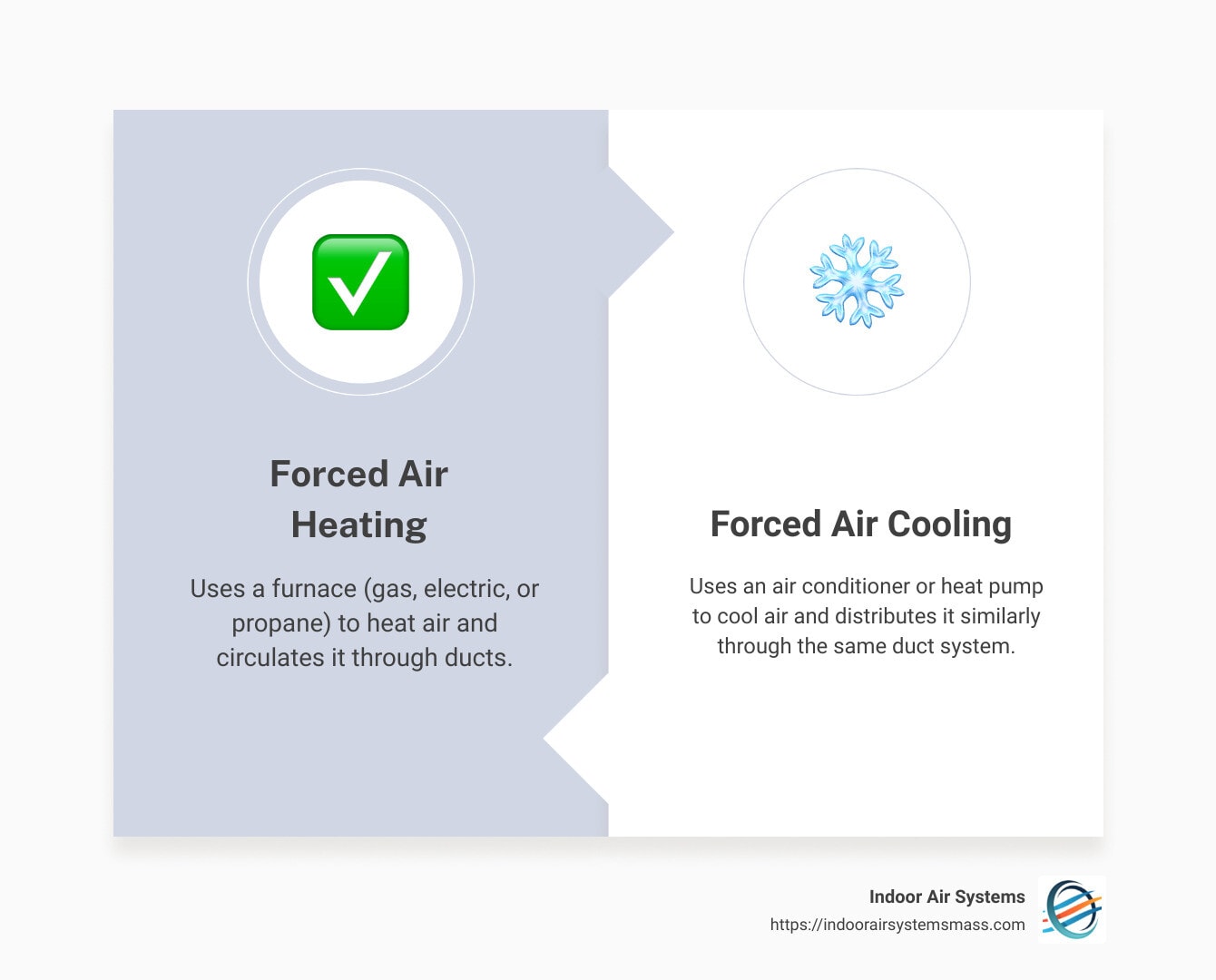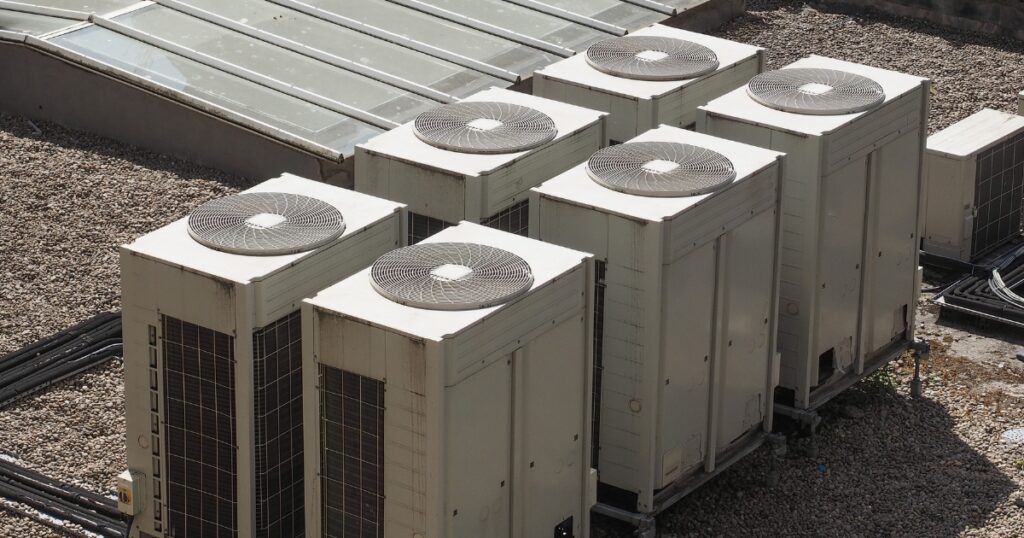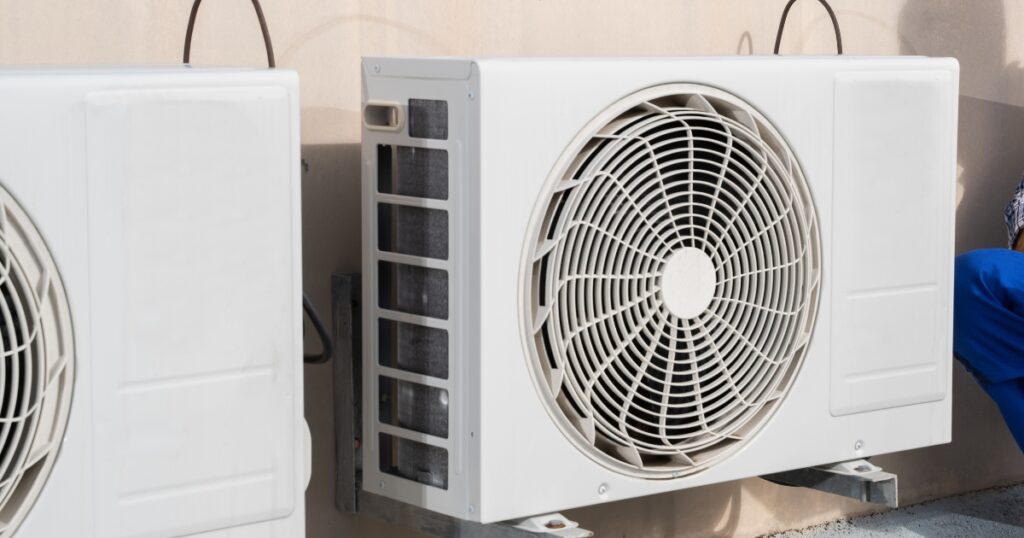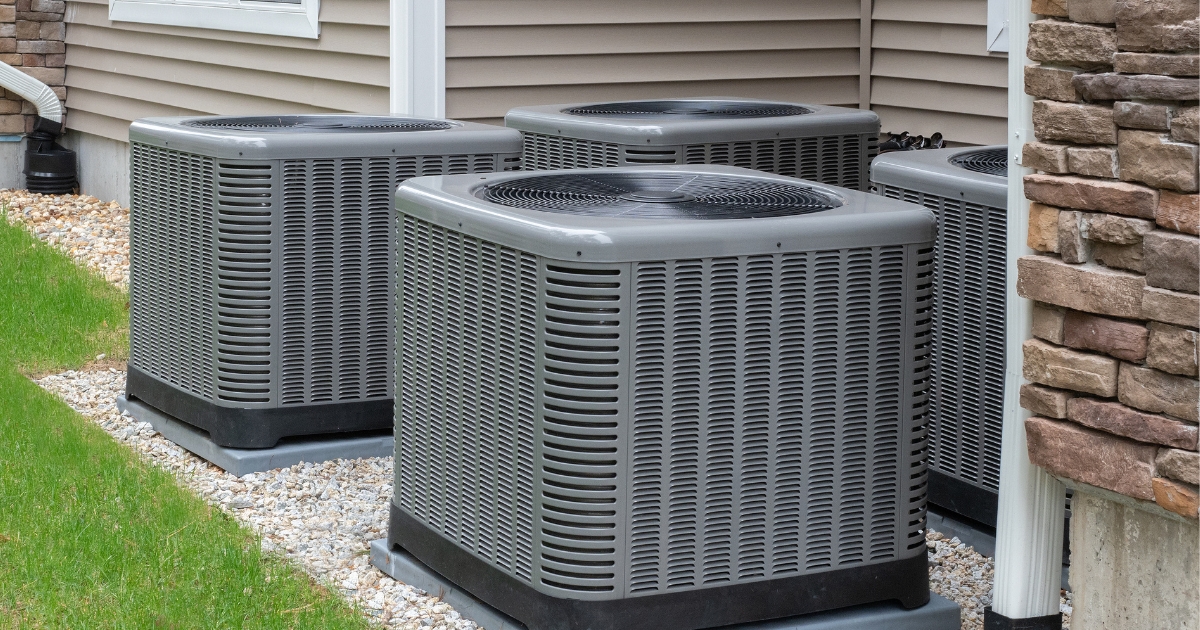Why Understanding Forced Air Heating and Cooling is Crucial
Forced air heating and cooling systems are common HVAC solutions that keep homes comfortable throughout the year. Understanding these systems can help you make smart choices for your home’s comfort, energy efficiency, and cost-effectiveness.
Quick answer to “What is forced air heating and cooling?”
- Forced Air Heating: Uses a furnace (gas, electric, or propane) to heat air and circulates it through ducts as part of a central heating system.
- Forced Air Cooling: Uses an air conditioner or heat pump to cool air and distributes it similarly through the same duct system.
These systems are integral to modern homes, and at Indoor Air Systems, we specialize in providing reliable and efficient HVAC solutions for Central Massachusetts homeowners. With over 20 years of experience, we prioritize professionalism and customer satisfaction in every service we provide.

Table of Contents
What is Forced Air Heating and Cooling?

Forced air heating is a popular HVAC system that heats your home efficiently. It uses a heat source such as a furnace or heat pump. Heat pumps collect warm air from outdoors and distribute it throughout the house. This heat source can be powered by electricity, natural gas, or propane. Here’s a simplified breakdown of how it works:
- Thermostat: You set your desired temperature on the thermostat. This device controls the heating operation.
- Furnace: When the temperature drops below the setting, the furnace kicks in. The furnace uses a heat exchanger to transfer heat from the fuel source to the air.
- Blower Fans: The heated air is then pushed by powerful blower fans through a network of air ducts.
- Ductwork: These ducts distribute the warm air to various parts of your home.
- Return Ducts: The cooler air returns to the furnace through return ducts, gets reheated, and the cycle continues.
Forced air cooling operates similarly to heating but in reverse. It uses an air conditioner or heat pump to cool the air. A central air conditioning system uses vents, ducts, and a plenum in a forced-air setup to deliver temperature-regulated air throughout the home.
Here’s how it works:
- Thermostat: You set your desired cooling temperature.
- Air Conditioner/Heat Pump: The system activates the air conditioner or heat pump. These devices remove heat from the air inside your home.
- Cooling Cycle: The air conditioner uses a cooling cycle involving refrigerants to absorb heat from the air.
- Air Handler: The cooled air is then passed through an air handler.
- Duct System: Just like in heating, the blower fans push the cooled air through the duct system to distribute it throughout your home.
- Return Ducts: Warmer air is pulled back into the system through return ducts to be cooled again.
By understanding both forced air heating and cooling, you can appreciate how these systems work together to maintain a comfortable climate in your home year-round.
Pros and Cons of Forced Air Heating and Cooling
When considering forced air heating and cooling for your home, it’s important to weigh the benefits and drawbacks. Forced air heating systems require regular maintenance to ensure energy efficiency and reliability. This will help you make an informed decision custom to your needs.
Pros
Quick Heating
One of the main advantages of forced air systems is their ability to heat your home quickly. The system directly heats the air and distributes it through ducts, providing almost instant warmth. This is particularly beneficial during cold winter months.
Energy-Efficient
Modern forced air systems are highly energy-efficient. They often use natural gas, which is more affordable and cleaner for the environment compared to other heating methods. New technology has also improved furnace efficiency, saving you money on utility bills.
Cost-Effective
Forced air systems are generally more cost-effective than other heating options like radiant heaters. The installation process is simpler, especially if your home already has ductwork for an existing air conditioning unit. This reduces both labor and material costs.
Easy Installation
If your home already has ductwork, adding a forced air heating system is straightforward. This can save you time and money on installation. It’s a convenient option compared to systems that require significant modifications to your home.
Reliability
Forced air systems are known for their reliability. They have fewer moving parts compared to electric or heat pump systems, reducing the likelihood of breakdowns. This means you can count on your system to keep your home comfortable, especially during extreme weather.
Cons
Noisy
Despite advancements in technology, forced air systems can still be noisy. The sound of air being pushed through ducts can be disruptive, especially if the system is not well-maintained.
Potential Health Risks
Forced air systems can circulate dust, allergens, and even mold throughout your home. If the system isn’t properly maintained, these particles can affect indoor air quality and potentially impact your health. Regular cleaning and maintenance are crucial.
Centralized Temperature Control
Forced air systems usually rely on a single thermostat to control the temperature throughout the home. This can lead to uneven heating or cooling, with some rooms feeling warmer or cooler than others. Zoning systems can help, but they add to the cost and complexity.
Leaky Ductwork
Over time, ductwork can develop leaks, reducing the system’s efficiency. Leaky ducts can also introduce pollutants into your home. Regular inspections and maintenance can help identify and fix these issues, but this adds to the overall upkeep.
By considering these pros and cons, you can decide if a forced air system is right for you. Next, we’ll compare forced air heating with central air to help you understand which might be a better fit for your home.
Forced Air Systems vs. Central Air

Key Differences
When it comes to heating and cooling systems, terms like forced air and central air can be confusing. Here’s a simple breakdown of how they differ:
Forced Air:
- Heating System: Uses a furnace or heat pump to heat air.
- Air Distribution: Employs a network of air ducts and vents to distribute heated air throughout the home.
- Components: Includes a thermostat, heat exchanger, blower fans, and ductwork.
- Cooling System: Can also use the same ducts to distribute cool air if an air conditioning unit or heat pump is added.
Central Air:
- Cooling System: Specifically designed to cool the home.
- Air Distribution: Uses the same air ducts and vents as a forced air system.
- Components: Includes an outdoor air conditioning unit, air handler, and evaporator coils.
- Heating System: Does not include heating components; typically pairs with a separate forced air heating system.
Which One is Better?
Choosing between forced air heating and central air depends on several factors. Let’s break it down:
Energy Efficiency:
- Central Air: Generally more energy-efficient for cooling because it’s designed specifically for that purpose. Check the AC SEER Rating for efficiency.
- Forced Air: Can be less energy-efficient, especially if the system is older or not well-maintained.
Air Quality:
- Central Air: Often includes advanced air purifiers, improving indoor air quality.
- Forced Air: Can circulate dust and allergens if not properly maintained. Regular filter changes are crucial.
Cost:
- Forced Air: Lower upfront cost for installation, especially if ducts are already in place.
- Central Air: Higher initial installation cost, but can save money in the long run due to better energy efficiency.
Installation:
- Forced Air: Easier and cheaper to install if the home already has ductwork.
- Central Air: More complex and expensive to install, particularly in homes without existing ducts.
Maintenance:
- Both Systems: Require regular maintenance such as filter changes, duct cleaning, and annual inspections to ensure peak performance and longevity.
In summary, if you’re looking for a cost-effective solution with lower upfront costs, a forced air heating system might be the way to go. However, if energy efficiency and improved air quality are your priorities, investing in a central airsystem could be more beneficial in the long run.
Next, we’ll dive into some essential maintenance tips to keep your forced air system running smoothly.
Maintenance Tips for Forced Air Systems

Keeping your forced air heating and cooling system in top shape is crucial for efficiency and longevity. Here are some essential maintenance tips:
Change the Air Filter
Change the air filter monthly or quarterly. A clean filter ensures good airflow and keeps dust and allergens out of your home. Clogged filters make your system work harder, which can lead to higher energy bills and potential damage.
Annual Inspection
Have your heating system inspected annually. An HVAC professional will check for any issues and perform necessary adjustments. This annual check-up helps catch small problems before they become expensive repairs.
Duct Cleaning
Clean the supply and return air ducts annually. Dust, mold, and other debris can accumulate in the ducts, reducing air quality and system efficiency. Regular cleaning helps keep your indoor air clean and your system running efficiently.
Thermostat Batteries
Maintain the thermostat batteries if equipped. A dead battery can cause your system to stop working, leaving you uncomfortable. Check and replace the batteries regularly to ensure your thermostat functions properly.
Carbon Monoxide Detectors
Maintain carbon monoxide detectors to ensure proper function. Forced air systems that use gas can produce carbon monoxide, a dangerous gas. Ensure your detectors are working to keep your home safe.
Monitor Energy Bills
Keep an eye on energy bills to catch any energy-use spikes. A sudden increase can indicate a problem with your system, such as a malfunctioning component or clogged filter. Monitoring your bills can help you catch and address issues early.
Conclusion
Choosing the right heating and cooling system for your home is crucial. At Indoor Air Systems, we specialize in providing top-notch HVAC services custom to your needs. With over 20 years of experience, our team is dedicated to ensuring your home remains comfortable all year round.
Living in Central Massachusetts, you know how extreme the weather can be. That’s why having a reliable HVAC system is essential. Indoor Air Systems is committed to delivering quality and trustworthy service, so you can focus on what matters most—enjoying a comfortable home.
We offer a range of services, from installing new systems to maintaining existing ones. Our personalized attention means we listen to your specific needs and provide solutions that work best for you. Whether it’s a routine maintenance check or an emergency repair, our responsiveness ensures you’re never left in the cold (or heat).
Ready to upgrade your home’s heating and cooling system? Contact us today at Indoor Air Systems for all your HVAC needs.
Frequently Asked Questions about Forced Air Heating and Cooling
What does heating and cooling forced air mean?
Heating and cooling forced air means using a system that heats or cools air in one location and then pushes it throughout your home using fans and ducts. This is part of an HVAC system that can use electricity, natural gas, or propane as a heat source. For cooling, it typically involves an air conditioner or heat pump. The main idea is to “force” the air through ducts to distribute it evenly across different rooms.
Is forced air heating gas or electric?
Forced air heating can be both gas and electric.
- Gas furnaces are more common and cheaper to run since natural gas is usually less expensive than electricity. They use a gas burner to heat air, which is then pushed through the duct system.
- Electric furnaces are quieter and eliminate the risk of carbon monoxide but are generally more costly to operate due to higher electricity prices. They use electric heating elements to warm the air.
Is forced air heating good?
Forced air heating has its pros and cons, making it a popular choice for many homeowners while not being perfect for everyone.
Pros:
- Quick Heating: It heats your home faster than other systems.
- Energy-Efficient: Modern forced air systems are highly energy-efficient.
- Cost-Effective: Especially if your home already has ductwork, it’s cheaper to install.
- Multi-functional: Can be combined with air conditioning using the same ducts.
Cons:
- Noisy: The system can be noisier than other heating options.
- Centralized Control: Requires centralized temperature control, which may not be ideal for all homes.
- Health Risks: If not well-maintained, it can circulate mold and allergens.
Knowing these benefits and drawbacks can help you decide if forced air heating is right for your home.
Our Content
At Indoor Air Systems, LLC, we provide specialized HVAC services with a personal touch. Serving Central Massachusetts, we focus on the installation and maintenance of mini-split systems, ensuring efficient and cost-effective heating and cooling solutions. Our locally owned and operated business allows us to offer exceptional customer attention and responsiveness without the high costs associated with larger companies. Choose Indoor Air Systems for reliable, expert service tailored to your specific needs.

